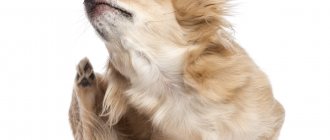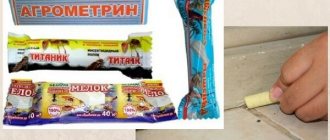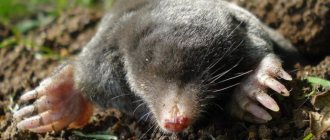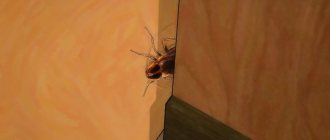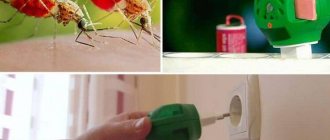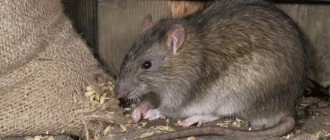Trichodectosis is a parasitic disease of dogs, the development of which is provoked by lice eaters.
Ectoparasites of this species have tiny sizes, not exceeding one and a half to two millimeters, a translucent or yellowish abdomen, and a disproportionately large head.
A distinctive feature of lice-eaters that parasitize the skin is the specificity of their diet: if the food source for common blood-sucking parasites is blood, then these pests prefer skin particles, dog hair, and fluff.
When infected with skin parasites, the dog shows constant anxiety, constantly itches, appetite and sleep deteriorate, and sores and scratches may appear on the skin. It is imperative to treat your dog using insecticides. We will consider below what methods will help get rid of parasites.
What are lice eaters?
Lice eaters in dogs are small insects that parasitize exclusively on the skin and fur of the animal. Ectoparasites are extremely small in size; the body length of an adult does not exceed two millimeters.
A distinctive feature of insects is their large rectangular head, flat body, and transparent integument. It is extremely difficult to detect lice eaters on a dog’s body; this can only be done through a close examination of the fur.
The reproduction process of these parasites is similar to lice and fleas: the female lice-eater lays several dozen eggs, attaching them to the fur using a special adhesive substance. Due to this factor, it is extremely difficult to get rid of parasite eggs by combing or washing. The only food sources for lice eaters are particles of skin, fur, and dried blood.
Trichocephalosis in dogs
We are talking about colonic diarrhea, which is caused by Trichocephalus vulpis. This pathogen is characterized by prevalence in regions with a humid and warm climate. The duration of preservation of Trichocephalus vulpis eggs can reach several years. Eating eggs by an animal is accompanied by the release of larvae in the large intestine. They penetrate into the submucosal space of the large intestine. Sexually mature individuals of the pathogen live for about a year.
First, the larvae penetrate into the submucosal layer of all parts of the large intestine. We are talking about the colon, ileum and rectum. As a result, an inflammatory process occurs there, caused by the accumulation of mononuclear blood cells (mononuclear cells). The location and extent of the lesion is influenced by the animal’s health status. Severe damage can lead to anemia. The cause is believed to be intestinal bleeding. Parasites can cause acute or chronic colonic diarrhea.
Clinical picture of the disease
Trichocephalosis in dogs is characterized by a variety of clinical signs. Both an asymptomatic course and the development of a severe disease are possible. This is influenced by the state of the animal’s immunity. It is worth noting that the severity of the lesion does not depend on the number of parasites in the large intestine. In most cases, the development of colonic diarrhea is noted. Trichocephalosis is also accompanied by weight loss, refusal to eat, and increased fluid consumption. When you feel the dog's abdomen, areas of pain are revealed. In severe cases, dehydration, decreased heart rate and decreased body temperature develop.
The detection of pathogen eggs is facilitated by the examination of feces. Note that a single negative result of such a diagnosis does not indicate the absence of trichocephalosis. This may be due to inconsistent egg release. Therefore, multiple analysis is required. It is possible to carry out diagnostic deworming. This method consists of the prophylactic use of antiparasitic drugs. In the presence of trichuriasis, such treatment leads to a weakening of symptoms. Adult parasites can be detected by colonoscopy. The severe course of the pathology is manifested by symptoms similar to those of mineralocorticoid deficiency. We are talking about a lack of chlorine and sodium in the body, as well as an increase in the level of potassium and nitrogen in the blood. However, trichocephalosis is characterized by normal test results using cortisol and aldosterone.
Trichocephalosis in dogs must be distinguished from the following pathologies:
1. Other causes of acute or chronic inflammation of the large intestine (salmonellosis, etc.). 2. The presence of other pathogens in the intestinal cavity, for example, roundworms. 3. Insufficient production of mineralocorticoids. 4. Tumor formations of the colon. 5. Disorders of motor function of the colon.
To eliminate the causative agents of trichuriasis, the use of fenbendazole is indicated. The dose of this drug is 50 mg/kg. The duration of such treatment does not exceed 3 days. The presence of other parasites in the gastrointestinal tract requires repeating treatment after 20 days. For severe dehydration, fluid therapy is given. To do this, use glucose, saline, etc.
Monitoring therapy by fecal examination is not recommended. This is due to the inconsistency of egg release. In case of relapse, fenbendazole is reused.
Source
Ways to combat lice eaters
When lice bites appear in a dog, treatment is required. Integrated control of parasites includes treating animal fur with special insecticidal agents that have a detrimental effect on adult parasites, larvae, and eggs. You can also use folk remedies, but more often their level of effectiveness is extremely low, and therefore it is better to use them for preventive treatment of wool.
Anti-hairworm medications for dogs
Before removing lice eaters from a dog through the use of antiparasitic agents, it is necessary to show the animal to a specialist.
Incorrectly selected medications can aggravate the symptoms and condition of the pet. Any means are selected according to the age characteristics of the animal, its breed, and the degree of infection.
Pediculicidal shampoos
Pediculicidal shampoos are moderately effective treatments against lice. Their advantages include softness and safety of action. Shampoos can be used to remove skin parasites from puppies and animals that are hypersensitive to aggressive insecticides. The most popular types are: Meadow, Phytoelite, Celandine.
To carry out anti-parasitic treatment of a dog, it is enough to apply a small amount of detergent to the coat, lather thoroughly, and then remove. After rinsing, it is important to comb out the parasites using a sparse comb.
It should be noted that shampoos actively moisturize the animal’s skin, promoting the healing of microdamages, hydration, and relieving itching.
Drops against lice
Drops for dogs against lice are among the highly effective products. A single use of drugs from this group allows you to rid the animal of parasites for several months and prevent re-infection. Before curing a dog of lice with drops, it is important to make sure that there are no wounds or damage on the animal’s skin.
Drops against lice with increased effectiveness are:
- Advantage.
- Snow leopard.
- Leopard.
To carry out the procedure, it is enough to apply a few drops of the selected insecticidal preparation to the withers area and allow the product to absorb into the skin. It is important to ensure that the medicine does not enter the animal’s digestive tract.
Pills
The easiest way to treat lice in dogs is to use chewable tablets. Drugs in this group have a pleasant taste, their duration of action ranges from one month to three. The tablets are completely safe for use, but have an average level of effectiveness.
Antiparasitic sprays and aerosols
Sprays and aerosols that have antiparasitic properties contain components similar to those contained in the drops. The advantage of spray products is the ability to apply over a large area.
To destroy lice eaters, the following types of aerosols are most often used: Defendog, Blokhnet. Before use, it is important to put a restrictive collar on your dog; this measure will help prevent toxic substances from entering the animal’s digestive tract.
Collars
The easiest way to treat lice eaters is to use antiparasitic collars. To get the effect, just put a collar on the animal. Before getting rid of lice in dogs in this way, it is recommended to bathe the animal using any insecticidal shampoo during the procedure. It should be noted that collars are excellent for preventing your pet from becoming infected with parasites.
Folk remedies
If for some reason the use of the insecticidal agents given above is not possible, folk remedies will help to cope with parasites.
The following are suitable for use at home:
- herbal decoctions. To carry out antiparasitic treatment of an animal, it is recommended to bathe the dog using a rich decoction of chamomile, string or wormwood.
- Dust soap. Works similarly to antiparasitic shampoo. To remove parasites, just thoroughly lather the animal's fur, wait a few minutes, rinse, and then comb out the insects.
It is recommended to use folk remedies only if there are a small number of parasites, since their effectiveness is low.
Clinical picture
The clinical picture of dogs affected by lice eaters is accompanied by the following symptoms:
- The dog is constantly itching.
- As a result of constant itching, multiple wounds appear on the dog’s body.
- Grayish-white small scales similar to dandruff appear on the body.
- On examination, we find small white grains on the dog’s fur, which move when examined closely.
- The dog's fur becomes dull, sticks together in clumps, and sometimes the hair may fall out.
- The dog loses its appetite (loss of appetite in the dog), thirst appears, and weight loss occurs.
- Visible mucous membranes are anemic (anemia in dogs).
- Due to constant itching, the dog sleeps little.
Diagnosis . Veterinary specialists at the clinic make a diagnosis of a dog being affected by lice eaters based on a clinical examination of the sick dog and detection of lice eaters at various stages of development (eggs, larvae and adult lice eaters). To make it easier to identify the ectoparasite, the dog is heated with an electric lamp so that the lice eaters come to the surface and become more visible.
Differential diagnosis . To exclude other ectoparasites in a veterinary clinic, specialists take a scraping from the skin and send it for microscopic examination to a veterinary laboratory.
Treatment . Owners of dogs affected by trichodectosis must keep in mind that lice eaters not only weaken the dog’s immunity, but can also cause certain functional disorders of the body and lead to a decrease in the barrier function of the skin. Additionally, lice eaters can be carriers of helminthic diseases in dogs (worms in dogs), pathogenic fungi (dermatophytosis, ringworm in dogs), leptospira (leptospirosis in dogs), as well as other infectious diseases. Dog owners should consult a veterinarian before starting treatment for trichodectosis.
When treating dogs affected by lice, special insecticidal preparations are used - sprays, drops and antiparasitic shampoos.
The course of treatment, taking into account the length of the life cycle of lice eaters, is 4-5 weeks.
The coat of a sick dog is treated 2-3 times with an interval of 7 days.
The most effective insecticidal preparations used in the treatment of trichodectosis are:
- Oxamate.
- Gomelin.
- Akrodex.
- Turingin –B.
- Dana.
- Advantix.
- Cyodrine.
- Dironet.
- Bolfo
- Bars - forte.
- Dermatosol.
- In-Up complex…
Drops.
Drops from lice in their composition contain insecticidal components, thanks to which they have a detrimental effect on parasites. This method of combating lice is one of the most effective. Additionally, the drops have a long period of protection: the product can not only remove lice-eaters already present in the dog’s fur, but also prevents the possibility of re-infection for a long time (up to 6-8 months). The medicine should be dripped into places that are inaccessible for licking (on the withers or spine). For drops in the treatment of lice, experts recommend using -Bars, Dana, Irbis, Advantage, In-AP
Shampoos.
When treating lice, special pediculicidal shampoos are used. Even puppies can be treated against lice with these shampoos. Shampoos have a moisturizing effect, which reduces the dog's itching. Most shampoos have a pleasant aroma and do not cause an allergic reaction in the dog. In addition, after using shampoo, the dog’s coat becomes smooth and silky.
Mode of application:
- The shampoo is applied to the wet fur of a sick dog.
- By using pediculicidal shampoos, we protect the dog’s eyes from the cleaning solution.
- To achieve the desired therapeutic effect, the washing solution is rubbed into the fur with massage movements, leaving it on the dog’s body for 5 minutes.
- After this, rinse the dog's fur thoroughly with water, dry it with a hairdryer and comb out dead insects.
Among the shampoos, it is recommended to use zoo shampoos: Fitoelita, Lugovoy, Demos-Lux, Bars (AVZ).
Symptoms of canine lice infestation
The appearance of lice eaters in dogs is fraught with the development of characteristic symptoms.
The following signs may indicate that an animal is infected:
- The animal shows constant anxiety, loses weight due to lack of appetite and severe thirst.
- Due to constant severe itching, scratches, wounds, and painful crusts may appear on the animal's skin.
- The condition of the coat deteriorates, it becomes duller, tangles form, and bald patches may form. In addition, small, whitish translucent dots appear on it - this is exactly what insects look like.
- Parasites can also be identified if there are dark dots on the fur, which are traces of the vital activity of parasites.
Lice eaters are especially often localized on the inside of the thighs, at the base of the tail, and head.
If the above signs appear that may indicate an invasion, the indicated areas should be thoroughly inspected.
Whipworm in dogs: general description
The length of whipworms is usually 5-8 cm, and the body can be compared to a thick needle (you can see what a dangerous worm looks like from the photo). The anterior end of the helminths is even thinner - it makes up ¾ of the total volume of the parasite. But the back part of the worm is larger in volume, which makes it characteristic among other types of helminths. Sometimes this causative agent of the disease can be even smaller in size, which indicates a recent infection of the pet with trichuriasis.
Attention! Whipworms feed on the blood of the animal - it is because of this that the pet develops symptoms of general intoxication of the body.
Whipworms in dogs usually live in the large intestine and appendix (also called the cecum). As worms penetrate the animal's gastrointestinal tract, they attach to the intestinal walls with the help of their thin tail, thereby piercing their mucous membrane (this can be clearly seen in the photo).
How does helminth infection occur? A dog can eat worm eggs that are found on food, digging in the ground or playing with toys that were lying on the street. Infection mainly occurs in the fresh air - whipworms are especially often observed in puppies, who like to pick up various garbage from the ground.
An animal, having swallowed worm eggs, feels absolutely healthy at first, but they soon mature and small-sized whipworms hatch from them. After a couple of days they descend into the small intestine. If other types of worms are not expelled from the pet, this type of parasite will actively develop in the intestines. Sometimes the symptoms of whipworm in dogs become apparent months after infection - this is due to the fact that the number of helminths in the gastrointestinal tract has become significant.
As soon as the dog swallows the eggs and the worms hatch from them, the animal will already feel worse. From this moment no more than 3 months should pass when adult females begin to lay eggs on their own.
Ways of infecting dogs with lice eaters
A common way for a healthy dog to become infected is through contact with a sick animal. A pet can become infected from other dogs by walking in a place where a sick animal was previously walked. When the first signs of infestation appear, it is important to immediately identify parasites in your pet.
Weakened dogs that do not receive enough important microelements from food are especially susceptible to infection. Also at risk are puppies, females during pregnancy, and old animals.
Possible complications
Long-term infection of a dog with lice eaters can cause the development of dermatological diseases, the appearance of wounds and scratches on the pet’s skin. It is possible to develop helminthiasis, which is carried by parasites. Due to severe itching, the animal becomes irritable and aggressive. In addition, exacerbation of chronic diseases, if any, is likely.
How dangerous are lice eaters?
In fact, insects are far from harmless creatures in relation to the health of your ward:
- These are carriers of helminths (in particular, tapeworms).
- These are carriers of infectious diseases.
- This is a possible dermatitis, eczema and other diseases (the result of scratching insect bites).
- These are complications in the form of a weakened immune system and exacerbation of chronic pathologies.
- This is a state of anemia, a manifestation of allergies.
To be fair, it is worth noting that lice eaters are not dangerous to people, since those creatures that are too “cold” and heat-loving for them die.
Preventive actions
To prevent the appearance of lice in dogs, you should promptly pay attention to the prevention of parasitic infestations. It is important to protect the animal from contact with stray relatives, and to avoid walking in places where there may be a large number of such dogs.
You need to monitor your pet’s diet; she should receive a sufficient amount of vitamins, minerals, and other important substances. No less important is the condition of the pet’s skin. Low level of hygiene, the presence of wounds, scratching can be considered among the factors contributing to the rapid increase in the number of parasites.
If your dog constantly walks outside, it is recommended to periodically use anti-parasitic shampoos and collars for prevention. These products will help protect your animal from infection for several months.
Answers to popular questions
Are canine lice eaters dangerous to people?
The only danger that insects can pose to people is the risk of infection with infectious diseases, helminthiasis, of which they are carriers. This can happen when the parasite enters the human digestive tract.
What is the main danger of having lice eaters in a dog? Parasites are carriers of many infectious diseases, helminthiases. If an insect is swallowed, there is a risk of infecting your pet with various types of tapeworms or other parasites.
Can a person get infected from a sick dog? The possibility of human infection is completely excluded, since the parasites quickly die outside the fur of an infected dog.
Good to know
- Intestinal adenocarcinoma in dogs and cats (diagnosis and treatment)
- Adenocarcinoma of the canine perianal glands (etiology, symptoms, diagnosis, treatment)
- Nutritional lymphoma in dogs and cats (etiology, pathogenesis, symptoms, diagnosis, treatment)
- Analysis of feces for helminths in dogs and cats
- Analysis of feces for digestibility in cats and dogs
- Peritoneal fluid analysis in dogs and cats
- Anal glands in cats (general information, control, diseases)
- Diverticulum and dilation (enlargement of the esophagus in cats and dogs (Megaoesophagus) - etiology, pathogenesis, diagnosis and treatment
- Ollulanus tricuspis of cats, dogs and foxes (etiology, symptoms, diagnosis and treatment)
- Physaloptera rara in dogs (etiology, symptoms, diagnosis, treatment)
- Salmonella spp. in dogs and cats (general information, pathogenicity)
- Spirocerca spp. nematode (Spirocerca lupi) of dogs
- Helicobacter Helicobacter spp. in cats (general characteristics, diagnosis and treatment)
- Canine abdominal hemangiosarcoma (etiology, symptoms, diagnosis, treatment)
- Anthelmintics for dogs and cats
- Vascular ring anomaly is a congenital defect
- Anorexia in dogs and cats
- Antacids in cats and dogs
- Antibacterial drugs in cats and dogs
- Bacterial diseases in gastroenterology of cats and dogs
- Abdominal pain in cats and dogs




